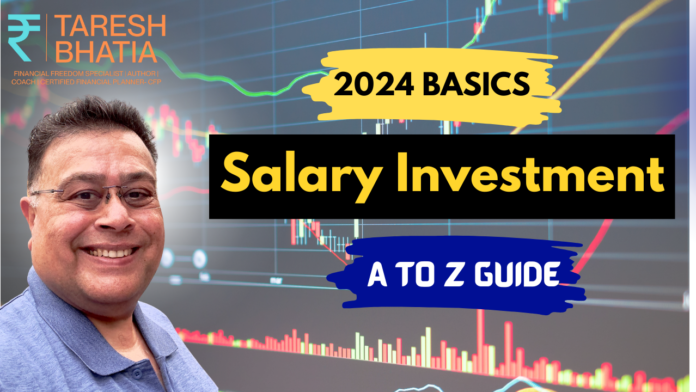Introduction
In today’s fast-paced financial landscape, achieving financial independence isn’t just a luxury—it’s a necessity. With the dual-income model becoming increasingly common in households, it’s more important than ever to make informed and strategic decisions about how to invest your salary. This comprehensive guide is tailored to earners, especially those with two earning members in the household, to help you maximize your earnings, set and achieve financial goals, and secure a prosperous future.
Understanding Investment Vehicles

The foundation of any successful investment strategy lies in understanding the various vehicles available. The most popular investment options include:
- Stocks: Investing in the stock market can yield high returns, but it also comes with significant risks. Companies like Reliance Industries, TCS, and Infosys are popular choices among investors.
- Bonds: These are more stable compared to stocks and provide fixed returns over a period. Government bonds and corporate bonds are common.
- Mutual Funds: These are investment vehicles that pool money from multiple investors to buy a diversified portfolio of stocks, bonds, or other securities. SIPs (Systematic Investment Plans) are particularly popular as they allow for disciplined investing.
- ETFs (Exchange-Traded Funds): ETFs are similar to mutual funds but are traded on stock exchanges, offering liquidity and flexibility.
Understanding these investment vehicles and how they can be combined effectively is the first step towards creating a diversified portfolio that aligns with your financial goals.
Goal Planning: The Key to Financial Success

Setting clear financial goals is crucial to creating a roadmap for your investments. Your goals can be divided into two main categories: short-term and medium-term.
Short-Term Goals (Up to 3 Years)
Short-term goals include immediate financial needs such as saving for a vacation, purchasing a vehicle, or making a down payment on a home. For these goals, you should focus on investments that are relatively low-risk and easily accessible. Some options include:
- Savings Accounts: While interest rates might be lower, savings accounts offer safety and liquidity, making them ideal for short-term goals.
- Fixed Deposits (FDs): FDs provide a higher interest rate compared to savings accounts and come with fixed tenures. They are secure and ideal for short-term financial planning.
- Recurring Deposits (RDs): RDs allow you to save a fixed amount regularly, accumulating a lump sum over time, which can be used for short-term goals.
Medium-Term Goals (5 to 10 Years)
Medium-term goals might include planning for your child’s education, purchasing a second property, or saving for a significant life event. For these goals, consider a mix of growth-oriented investments:
- Balanced Mutual Funds: These funds invest in both equities and debt, providing a balanced approach that mitigates risk while offering growth potential.
- Real Estate: Investing in property can provide substantial returns over the medium to long term. It’s crucial to research thoroughly before investing.
- Gold: Gold has traditionally been a safe haven and is an excellent medium-term investment, especially during times of economic uncertainty.
Salary Slabs: Tailoring Your Investments
Your investment strategy should align with your income level. Here’s how you can tailor your investments based on different salary slabs:
Low-Income Earners
If you fall into the low-income bracket, your focus should be on building a strong financial foundation. Prioritize emergency savings, health insurance, and low-risk investments like fixed deposits or government bonds.
- Emergency Fund: Start with an emergency fund that covers at least three months of living expenses.
- Health Insurance: Ensure you have adequate health insurance coverage to protect against medical emergencies.
- Low-Risk Investments: Consider FDs or RDs that offer security and steady returns.
Middle-Income Earners
For middle-income earners, the focus should be on diversifying investments and planning for medium-term goals.
- Mutual Funds: SIPs in diversified mutual funds can help you grow your wealth over time.
- PPF (Public Provident Fund): This is a safe, long-term investment option that offers tax benefits and decent returns.
- Term Insurance: Protect your family’s future with a term insurance policy that covers life risks.
High-Income Earners
High-income earners should focus on aggressive growth strategies while ensuring they have a solid financial safety net.
- Equity Investments: Direct stock market investments or equity mutual funds can offer high returns over time.
- Real Estate: Consider investing in commercial properties or second homes for rental income.
- Wealth Management: Engaging with a wealth manager can help you create a comprehensive investment plan tailored to your goals.
Allocating Investments Per Earning Member
When there are two earning members in the household, it’s important to allocate investments strategically. Here’s how to do it effectively:
- Divide Responsibilities: One member can focus on short-term goals while the other handles long-term investments. This way, the household can ensure liquidity while building wealth over time.
- Joint Investments: Consider joint investments in real estate or mutual funds to pool resources and maximize returns.
- Separate Savings: Maintain separate emergency funds for each member to ensure financial security in case of job loss or other unforeseen circumstances.
- Insurance: Both members should have individual life and health insurance policies to cover personal and family risks.
Creating a Financial Plan for Your Salary

A well-structured financial plan is the cornerstone of successful salary management. Here’s a step-by-step guide to creating one:
- Assess Your Income and Expenses: Start by calculating your total household income and breaking down your monthly expenses. This will give you a clear picture of your financial standing.
- Set Financial Goals: Based on your income, set realistic short-term and medium-term goals. This could include building an emergency fund, saving for a down payment, or planning a vacation.
- Allocate Investments: Based on your goals, decide how much of your salary to allocate towards savings, investments, and insurance. Ensure that your investments align with your risk tolerance and time horizon.
- Review and Adjust: Regularly review your financial plan to ensure it stays aligned with your goals. Adjust your investments as necessary to accommodate changes in income, expenses, or financial objectives.
Assumptions and Scenarios

Every financial plan is based on certain assumptions, such as expected returns, inflation rates, and life expectancy. These assumptions help in creating realistic financial scenarios:
- Expected Returns: Assume a conservative rate of return on your investments to avoid overestimating your future wealth. For example, equity investments might be expected to return 8-12% annually, while debt instruments could return 5-7%.
- Inflation: Consider an inflation rate of 4-6% when planning for long-term goals like retirement. This will ensure that your savings grow in real terms.
- Life Expectancy: Plan for a longer life expectancy to avoid the risk of outliving your retirement savings. It’s advisable to plan for at least 20-30 years post-retirement.
Financial Planning for Salaried Individuals

Salaried individuals have a predictable income, which can be a significant advantage in financial planning. Here are some tips:
- Automate Savings: Set up automatic transfers to your savings or investment accounts to ensure consistent contributions towards your financial goals.
- Utilize Bonuses Wisely: Use any bonuses or increments to boost your investments or pay off debt rather than spending on non-essential items.
- Leverage Employer Benefits: Take full advantage of employer-provided benefits such as health insurance, EPF (Employees’ Provident Fund), and gratuity to enhance your financial security.
Financial Planning for Private Sector Employees

Private sector employees often face greater job volatility compared to government employees. Here’s how to plan for such uncertainties:
- Emergency Fund: A robust emergency fund is crucial, ideally covering 6-12 months of expenses.
- Diversified Portfolio: Maintain a diversified investment portfolio to protect against market volatility.
- Retirement Planning: Don’t rely solely on employer-provided retirement benefits. Consider additional retirement savings options like NPS or PPF.
- Health Insurance: Ensure you have adequate health insurance coverage, especially if your employer’s policy is insufficient or you switch jobs frequently.
Insurance Essentials: Life and Health Insurance

Insurance is a critical component of any financial plan, protecting you and your family from unforeseen events. Here’s what you need to consider:
- Life Insurance: Term insurance is the best option for life cover. It provides a high sum assured at a low premium, ensuring your family’s financial security in case of your untimely demise.
- Health Insurance: Health insurance is essential to cover medical expenses. Opt for a comprehensive health plan that covers hospitalization, surgeries, and critical illnesses.
- Riders: Consider adding riders to your insurance policies, such as accidental death, critical illness, or waiver of premium, to enhance your coverage.
Building a 6-Month Emergency Fund
An emergency fund acts as a financial safety net, ensuring that you can handle unexpected expenses without derailing your financial plan. Here’s how to build one:
- Calculate Your Needs: Start by calculating your monthly expenses, including rent, utilities, groceries, and other essentials. Multiply this amount by six to determine the size of your emergency fund.
- Choose the Right Account: Keep your emergency fund in a liquid and easily accessible account, such as a savings account or a short-term FD.
- Automate Savings: Set up an automatic transfer from your salary account to your emergency fund every month until you reach your target amount.
- Avoid Temptations: Resist the urge to dip into your emergency fund for non-emergencies. It’s crucial to keep this fund intact for genuine financial crises.
Retirement Planning

Retirement planning is one of the most critical aspects of financial planning. Here’s how to ensure you have a secure and comfortable retirement:
- NPS (National Pension System): The NPS is a government-backed pension scheme that offers tax benefits and a steady income stream post-retirement. It’s a low-cost, long-term investment option that provides both equity and debt exposure.
- PPF (Public Provident Fund): PPF is another long-term investment option that offers tax benefits and guaranteed returns. It’s ideal for risk-averse investors looking to build a retirement corpus.
- EPF (Employees’ Provident Fund): If you’re employed, your EPF contributions are a significant part of your retirement planning. Ensure that you don’t withdraw from your EPF account before retirement to allow your corpus to grow.
- Non-Redeemable Investments: Consider investments that cannot be easily redeemed, such as long-term FDs or real estate, to ensure that your retirement funds remain intact until you need them.
Summary and Disclaimer
In this guide, we’ve covered everything you need to know about investing your salary like a pro. From understanding investment vehicles and setting financial goals to tailoring your investments based on your salary slab, this guide provides a comprehensive roadmap for achieving financial independence.
However, it’s important to remember that all investments carry risks, and it’s crucial to consult with a certified financial planner before making any significant financial decisions. This guide is intended to provide general advice and should not be taken as personalized financial planning.
Conclusion and Call to Action
Investing your salary wisely is one of the most important steps you can take towards financial independence. By understanding your options, setting clear goals, and creating a comprehensive financial plan, you can build a secure and prosperous future for yourself and your family.
Don’t wait—begin your journey to financial independence today. Subscribe to our blog for more insights, leave a comment with your investment experiences, and share this guide with your network. Together, we can achieve financial freedom!
The author of this article, Taresh Bhatia, is a Certified Financial Planner® and advocate for female empowerment. For more information and personalized financial guidance, please contact taresh@tareshbhatia.com
He has authored an Amazon best seller-“The Richness Principles”. He is the Coach and founder of The Richness Academy, an online coaching courses forum. This article serves educational purposes only and does not constitute financial advice. Consultation with a qualified financial professional is recommended before making any investment decisions. An educational purpose article only and not any advice whatsoever.
©️2025: All Rights Reserved. Taresh Bhatia. Certified Financial Planner®
Subscribe Now for Upcoming Blogs!
[convertkit form=6555951]
📢 Join free live webinar —
Couple Finance Formula™ Register here




